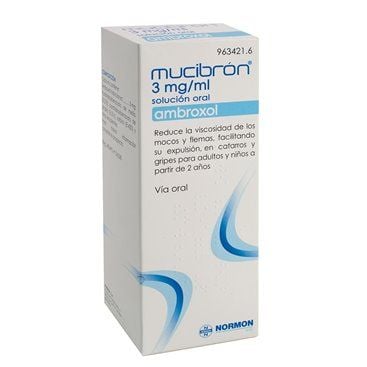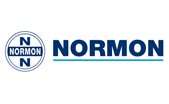Mucibron 3 Mg/Ml Oral Solution 200 Ml
Reduction of the viscosity of mucous secretions, facilitating their expulsion, in catarrhal and flu processes.
Reduction of the viscosity of mucous secretions, facilitating their expulsion, in catarrhal and flu processes.
Mucibron (3 Mg / Ml Oral Solution 1 Bottle 200 Ml)
Ambroxol hydrochloride
ACTION AND MECHANISM
- Mucolytic, expectorant. Ambroxol is N-desmethyl-bromhexine, the active metabolite of bromhexine. Its administration leads to a decrease in the viscosity of bronchial secretions and an increase in their volume, while promoting their expulsion.
Its mechanism of action is unknown, but it could be related to the increase in the synthesis of sialomucins by activation of the sialyl-transferase, which would restore the normal composition of glycoproteins of the bronchial mucus secretion, and normalize the viscoelasticity of the bronchial mucus .
It could also stimulate the mucous glands of the bronchial epithelium, increase lysozyme levels, which would cause the breakdown of mucopolysaccharides, and stimulate mucociliary activity.
PHARMACOKINETICS
- Absorption: it is rapidly and completely absorbed after oral administration, reaching a cmax of 88.8 ng / ml after 1-2.5 h (30 mg po, immediate release) or 6.5 h (prolonged release forms). After oral administration, it suffers a first-pass effect, eliminating 30% of the dose. Its bioavailability is 79%.
Effect of food : no clinically significant effect on the pharmacokinetics of ambroxol.
- Distribution: rapid distribution in the body, with a distribution t1 / 2 of 1.3 h. It tends to accumulate especially in the lung, reaching tissue concentrations up to 17 times the cp. The plasma protein binding is 90% and the Vd 552 l. Ambroxol crosses the placenta and is excreted in milk.
- Metabolism: it is metabolized in the liver by hydrolysis and glucuronoconjugation through CYP3A4, giving rise to dibromoanthranilic acid (10%) and other metabolites in small quantities.
- Elimination: it is eliminated in urine (83%), recovering 26% as conjugates and 6% unchanged. The t1 / 2 is 10 h and the CLt is 660 ml / min.
Pharmacokinetics in special situations :
- Renal impairment: no pharmacokinetic data are available.
- Hepatic failure: CP increases 1.3-2 times.
No significant pharmacokinetic differences were found due to age or sex.
INDICATIONS
- [BRONCHIAL HYPERVISCOSITY].
* Reduction of excessive bronchial viscosity in [COMMON COLD] and [FLU].
POSOLOGY
- Adults, oral: 30 mg / 8 h.
- Children and adolescents under 18 years of age, oral:
* Adolescents> 12 years: 30 mg / 8 h.
* Children 6-12 years: 15 mg / 8 h.
* Children 2-5 years: 7.5 mg / 8 h.
* Children <2 years: contraindicated.
- Elderly, oral: does not require dosage adjustment.
Administration with food : it is recommended to administer without food.
Duration of treatment : consult your doctor if symptoms do not improve after 5 days.
DOSAGE IN KIDNEY INSUFFICIENCY
It may be necessary to reduce the dose or increase the interval between dosages.
DOSAGE IN LIVER INSUFFICIENCY
It may be necessary to reduce the dose or increase the interval between dosages.
RULES FOR CORRECT ADMINISTRATION
It is recommended to drink a glass of water after each dose. Drink plenty of water during the treatment.
CONTRAINDICATIONS
- Hypersensitivity to ambroxol, bromhexine or any other component of the drug.
- Children <2 years. Risk of bronchial obstruction.
PRECAUTIONS
- Patients with severe [KIDNEY INSUFFICIENCY] (CLcr <30 ml / min) or severe [HEPATIC INSUFFICIENCY] (Child-Pugh class C), given the risk of accumulation.
- Gastric damage. The administration of mucolytics has been associated with disruption of the gastric protective barrier and gastric damage. Assess its use in patients with a history of [GASTRITIS] or [PEPTIC ULCER].
- Skin reactions. Administration of ambroxol has been associated with the occurrence of serious and life-threatening cutaneous adverse reactions, such as [TOXIC EPIDERMAL NECROLYSIS] or [STEVENS-JOHNSON SYNDROME]. In case of appearance or worsening of lesions on the skin or mucous membranes, ambroxol will be discontinued and a diagnosis of the patient will be made.
PRECAUTIONS RELATING TO EXCIPIENTS
- This medicine contains sorbitol. Patients with hereditary [FRUCTOSE INTOLERANCE] should not take this medicine.
ADVICE TO THE PATIENT
- Drink plenty of water during the treatment.
- Do not use cough suppressants while using ambroxol.
- Consult with the doctor and / or pharmacist if the symptoms worsen or do not improve in 5 days, or if fever, headache or sore throat appear.
- Inform your doctor and / or pharmacist if skin rashes appear during treatment, sometimes associated with the appearance of blisters or lesions on the mucous membranes.
SPECIAL WARNINGS
- The use of mucolytics and expectorants in children under 2 years of age is contraindicated as a consequence of the risk of bronchial obstruction.
- In case of appearance of cutaneous eruptions on skin or mucosa, ambroxol will be suspended and the possibility of pictures such as toxic epidermal necrolysis or Stevens-Johnson syndrome will be evaluated.
INTERACTIONS
- Antibiotics. The administration of ambroxol could increase the levels of antibiotics such as beta-lactams, macrolides or tetracyclines in the lung tissue.
- Antitussives. Risk of bronchial obstruction, due to the inhibition of the cough reflex, and the increase in the production and / or fluidization of mucus. Avoid association.
- Anticholinergics (atropine, antihistamines, tricyclic antidepressants, antiparkinsonians, neuroleptics, MAOIs). They could oppose the effect of ambroxol.
PREGNANCY
Safety in animals : Ambroxol did not cause teratogenic or embryotoxic effects at doses of 3,000 mg / kg / 24 h (rat) or 200 mg / kg / 24 h (rabbit). Cases of decreased fetal body weight and the number of live offspring were reported at maternotoxic doses.
Safety in humans : clinical use has not revealed side effects on pregnancy or postnatal development when administered from the 28th week of gestation. There are no adequate and well-controlled studies in humans. Its administration is only accepted if there are no safer therapeutic alternatives, and the benefits outweigh the possible risks.
Effects on fertility : Ambroxol did not cause secondary effects on fertility in male or female animals at a dose of 500 mg / kg / 24 h. No specific studies have been conducted in humans.
LACTATION
Ambroxol is excreted with milk. The consequences for the infant are unknown. Is recomended to suspend the lactancy or evy the administration.
KIDS
The use of mucolytics in children under 2 years of age has been related to the appearance of bronchial obstruction, as a consequence of increased production and fluidization of bronchial secretion and insufficient bronchial drainage. Therefore, the use of mucolytics in these children is contraindicated.
In older children, the pharmaceutical form and dose should be adapted to the age of the child ( see Dosage ).
SENIORS
No specific problems have been described in the elderly that require a dosage adjustment.
EFFECTS ON DRIVING
It seems unlikely that ambroxol could adversely affect the ability to drive.
ADVERSE REACTIONS
Adverse reactions are described according to each frequency range, being considered very common (> 10%), common (1-10%), uncommon (0.1-1%), rare (0.01-0.1%) , very rare (<0.01%) or of unknown frequency (cannot be estimated from the available data).
- Digestive: frequent [NAUSEAS], [DYSGEUSIA], [HYPOESTHESIA] oral; uncommon [VOMITING], [DIARRHEA], [DYSPEPSIA], [ABDOMINAL PAIN], [DRY MOUTH]; rare dry throat.
- Dermatological: rare [EXANTEMATIC ERUPTIONS], [URTICARIA]; frequency unknown [ERYTHEMA MULTIFORME], [STEVENS-JOHNSON SYNDROME], [TOXIC EPIDERMAL NECROLYSIS], acute generalized exanthematous pustulosis.
- Allergic: rare [HYPERSENSITIVITY REACTIONS]; frequency unknown [ANAPHYLAXIA], [ANGIOEDEMA], [PRURITO].
ADVERSE REACTIONS RELATING TO EXCIPIENTS
- Because it contains methyl parahydroxybenzoate, it can cause [HYPERSENSITIVITY REACTIONS] (possibly delayed).
- Because it contains propyl parahydroxybenzoate, it can cause [HYPERSENSITIVITY REACTIONS] (possibly delayed).
OVERDOSE
Symptoms : No serious reactions from ambroxol poisoning have been reported. As a general rule, the administration of doses of 15 mg / kg / 24 h (iv) or 25 mg / kg / 24 h (po) was well tolerated. Symptoms of the overdose included nervousness and diarrhea. In severe overdose, hypersalivation, nausea and vomiting and hypotension have been reported.
Measures to be taken :
- Antidote: there is no specific antidote.
- General elimination measures: the establishment of measures such as induced emesis or gastric lavage is not indicated, except in the case of very serious intoxication. Forced diuresis or dialysis do not appear to be effective measures for the treatment of overdose due to their high plasma protein binding.
- Patient care: keep the airways free of secretions, lying down and practicing a bronchial aspiration.
- Treatment: symptomatic treatment.



